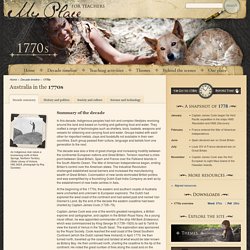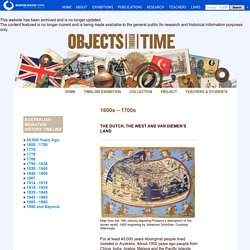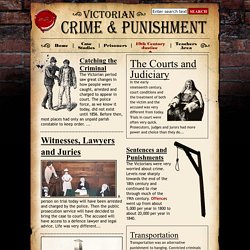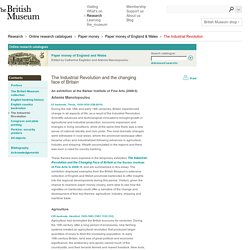

Australia's migration history timeline. Black-eyed Sue and Sweet Poll of Plymouth taking leave of their lovers who are going to Botany Bay, Robert Sayer, 1792.

Courtesy National Library of Australia By the 1790s British Investors were purchasing 38,000 slaves a year. Over sixty percent of the world’s slave trade was transported in British ships. Slavery and the feudal farm system were under attack by evangelical reformers who fought for personal liberty and the right of the individual. Industrials too had become opposed to slavery and the feudal farm system for they had discovered that for manufacturers, it was not economical to rely on a captive work force who along with their families, had to be fed, clothed and housed on a daily basis. European voyages to the Australian continent HTML version. European voyages to the Australian continent explores Australia through four themes: trade, navigation, science and empire.

Learn more about the voyages and how the objects carried by different voyagers were made, used or conserved. Explore the Flash interactives Launch the Banks’ Florilegium Flash interactive (Flash 9 compatible – download Flash) Launch the Voyaging with a needle Flash interactive (Flash 9 compatible – download Flash) Explore the HTML version Trade Europeans first came to the Australian continent via trade routes to and from Asia.
Navigation. European Exploration & Colonization of Australia. Why did Europeans settle in Australia? 1780s. When the War of American Independence (1775–83) ended, Great Britain lost its American colonies and was deprived of a place to dispose of its convicts.

During the war, Great Britain could not transport convicts and their numbers had increased significantly. The convicts were jailed in the hulks of old dilapidated warships moored in Plymouth and on the Thames estuary. Pressure to find another site for transportation mounted. In July 1783, James Matra (1746? –1806), who had visited Botany Bay in 1770 as a junior officer on the Endeavour, produced A Proposal for Establishing a Settlement in New South Wales. 1770s. In this decade, Indigenous peoples had rich and complex lifestyles revolving around the land and based on hunting and gathering food and water.

They crafted a range of technologies such as shelters, tools, baskets, weapons and vessels for obtaining and carrying food and water. Groups traded with each other for important metals, clays and foodstuffs not available in their own countries. Each group passed their culture, language and beliefs from one generation to the next. South Land to New Holland - Homepage. Australia's migration history timeline. Map from the 15th century depicting Ptolemy’s description of the known world, 1482 engraving by Johannes Schnitzer.

Courtesy Wikimedia For at least 40,000 years Aboriginal people lived isolated in Australia. History - British History in depth: The American War of Independence: The Rebels and the Redcoats. Images from history: Rarely-seen photographs bring 1800s London back to life. By Eddie Wrenn for MailOnline Updated: 10:00 EST, 11 August 2009 In the frantic pace of modern life, it is easy to forget our past, and the toils of the generations before us who built the world we live in.

But for those familiar with our capital city, these fascinating pictures taken when photography was in its infancy will bring back to life a London which has changed so much over the last 150 years. They capture sweaty, mustachioed long-dead engineers working hard to bring the world's first Underground network to life; they capture the hippo who entertained Londoners and visitors alike during his 30 years' lodgings at Regent's Park; they capture long-past shops and factories; they even capture the construction of one of England's most famous monuments, Nelson's Column, back in 1844.
Further afield, there are pictures of Italy, America, Japan and Egypt, all taken more than 100 years ago. As London became more industrialised, concern grew that historic parts of London were being lost. D. History - British History in depth: Beneath the Surface: A Country of Two Nations. Why were convicts transported to Australia? Behind the News : First Fleet. Poverty in Georgian Britain. Hidden Lives Revealed - Poverty and Families in the Victorian Era. Punishment 1750-1900. What was the purpose of the punishments used in the period 1750-1900?

During the period covered by this Gallery there were serious debates about the purposes of punishment. Many new ideas were tried in answer to the old problem of what to do with those who break the law. Gradually, through this period, the older "shaming" punishments like the stocks and the pillory fell out of use. So did whipping.
Fewer and fewer people were hanged. It was believed that crimes were committed by a "criminal class", so removing the offenders from the country should cause crime to decline; Little was known about Australia, so fear of the unknown might deter people from committing crimes; The convict had the chance to think about changing his or her ways. 19th century governments were prepared to get involved in many aspects of society which governments had not ventured into before. Case-Studies: 1. 19th Century justice - Victorian Crime and Punishment. Catching the Criminal The Victorian period saw great changes in how people were caught, arrested and charged to appear in court.

The police force, as we know it today, did not exist until 1856. Before then, most places had only an unpaid parish constable to keep order. ... Witnesses, Lawyers and Juries A person on trial today will have been arrested and charged by the police. Conditions in the Early 1800's - Victorian Crime and Punishment from E2BN.
Sydney Living Museums. Skip to main content Mobile Menu Search form Hyde Park Barracks Search [Prison hulk loading] [Prison hulk loading], Samuel Atkins, 1787–1808, watercolour. Convict hulks Convict Hulks. Convict hulk. Old Police Cells Museum. British Navy in Action en.wikipedia.org- The forbidding form of the beached convict ship HMS Discovery at Deptford The hulk Warrior (1781) anchored off Woolwich. © National Maritime Museum, London.

Prison hulks on the River Thames - Crime and punishment - Port Cities. KS3 Bitesize History - The Industrial Revolution : Revision, Page 2. Definition, Facts, & Summary. Industrial Revolution, in modern history, the process of change from an agrarian and handicraft economy to one dominated by industry and machine manufacturing. This process began in Britain in the 18th century and from there spread to other parts of the world.
Although used earlier by French writers, the term Industrial Revolution was first popularized by the English economic historian Arnold Toynbee (1852–83) to describe Britain’s economic development from 1760 to 1840. Since Toynbee’s time the term has been more broadly applied. Top Questions. The Industrial Revolution and the changing face of Britain. An exhibition at the Barber Institute of Fine Arts (2008-9)

Industrial Revolution - Facts & Summary. The textile industry, in particular, was transformed by industrialization. Before mechanization and factories, textiles were made mainly in people’s homes (giving rise to the term cottage industry), with merchants often providing the raw materials and basic equipment, and then picking up the finished product. Workers set their own schedules under this system, which proved difficult for merchants to regulate and resulted in numerous inefficiencies.
In the 1700s, a series of innovations led to ever-increasing productivity, while requiring less human energy. For example, around 1764, Englishman James Hargreaves (1722-1778) invented the spinning jenny (“jenny” was an early abbreviation of the word “engine”), a machine that enabled an individual to produce multiple spools of threads simultaneously. Coal, Steam, and The Industrial Revolution: Crash Course World History #32.